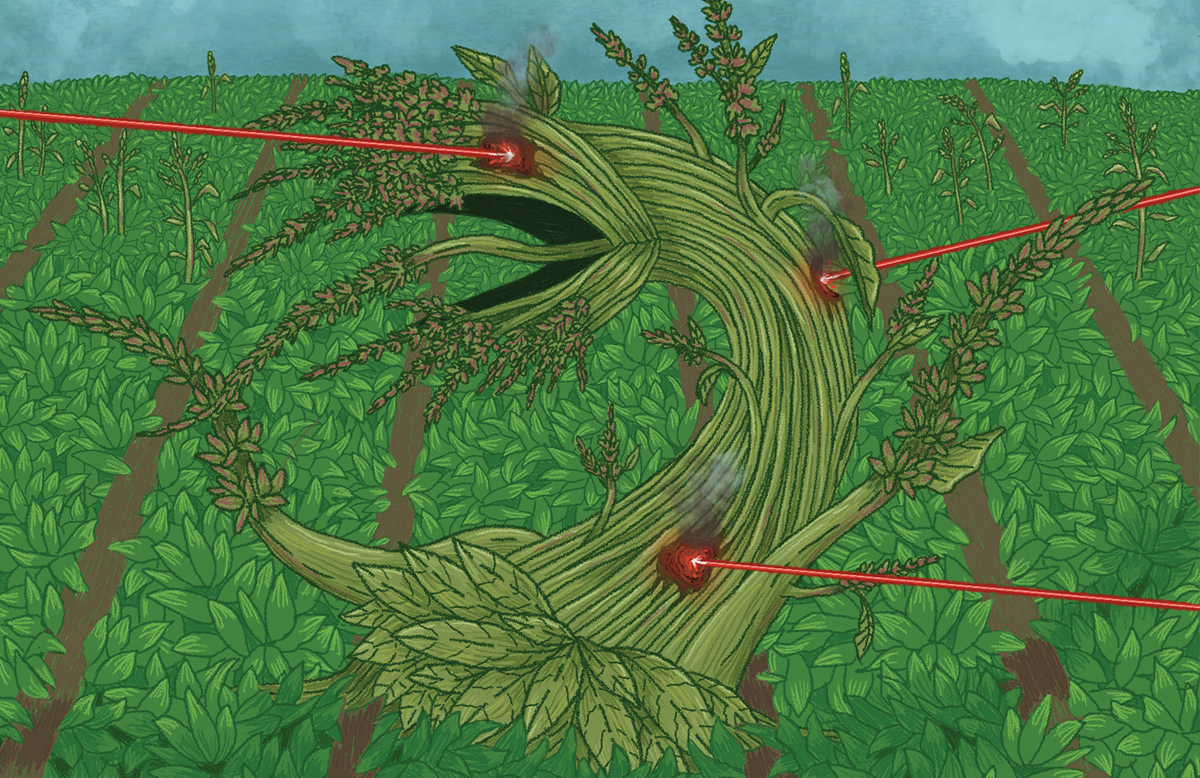Front List
When Weeds Refuse to Die
Six facts about herbicide resistance that may seem like science fiction

Synthetic herbicides were introduced to agriculture shortly after World War II. Affordable, reliable, and effective, they rapidly became the mainstay for weed management. Today, however, this strategy is going to seed as herbicide-resistant weeds dominate the landscape. For many years, target-site herbicide resistance was the primary culprit, but metabolic resistance is becoming more common. The mechanisms underlying this problem — and some of the potential solutions — may seem more at home in a science fiction movie than in a farm field.
1. In target-site resistance, the chemical puzzle pieces no longer fit together. Most herbicides control weeds by blocking enzymes critical to a plant’s function and growth, such as photosynthesis. In target-site resistance, weeds with a genetic mutation are selected unintentionally. This creates an altered target site where the herbicide compound no longer fits, and the enzyme continues to function. If that altered target site trait is passed on to the next generation via weed seed production, the population becomes herbicide resistant.
2. In metabolic resistance, generalist enzymes “digest” the herbicide before it can damage the weeds. The enzymes break down the herbicide into metabolites that are less mobile and less toxic to the plant and then dump the weakened molecules into plant parts where they are sequestered and rendered inactive. This process may sound more akin to the absorptive abilities of Hollywood’s The Blob (1958) than a plant.
3. Metabolic resistance is biologically intriguing but agriculturally challenging. The enzymes responsible for metabolic resistance are found in plants and insects (and also humans) and generally attack stressors, which, in the case of weeds, can include herbicides. In practical terms, this makes agricultural weed management very unpredictable: Metabolically resistant weeds can overcome herbicides that chemists have yet to even imagine, a seemingly anticipatory capability that, if we didn’t know better, might be mistaken for ESP.
4. The combination of target-site and metabolic resistance has become the norm rather than the exception for some common weeds. For example, waterhemp is not a new weed in Wisconsin agriculture, but it has become more widespread among field crops in recent years and is almost always resistant to at least one herbicide site of action. In cases across the grain belt, a single plant can resist six or more types of herbicides. This leaves farmers with few practical management options, a growing seed bank of resistant weed populations, and reduced crop production.
5. Metabolic enzymatic activities are also not specific to plants and herbicides, which makes for complex resistance scenarios. For example, CALS entomologists have found that some of the fungicides commonly used for potato disease control can upregulate metabolic enzyme production in Colorado potato beetles. The resulting increase in enzymatic activity impairs insecticide performance. It’s another sci-fi hallmark: the sometimes-challenging consequences of scientific advancements.
6. Lasers could be a solution to weeds. At CALS, we’re working with Wisconsin farmers to adopt innovative weed management strategies, including laser weeders. These machines use high-resolution cameras to scan the ground while rolling across the field; artificial intelligence to separate crops from undesirable plants in real time; and lasers to zap weeds up to every 50 milliseconds with submillimeter accuracy. It may feel speculative, but it’s very real — and it’s the kind of bold, advanced solution that’s needed to keep agriculture thriving.
Jed Colquhoun is professor and extension specialist in the Department of Plant and Agroecosystem Sciences. His research and outreach focus on commercial specialty crop production. He is director of UW’s Integrated Pest Management program and a member of Extension’s Crops and Soils team.
This article was posted in Food Systems, Front List, Healthy Ecosystems, Summer 2025 and tagged herbicide resistance, Jed Colquhoun, metabolic resistance, plant and agroecosystem sciences, target-site resistance, UW–Madison Division of Extension.

